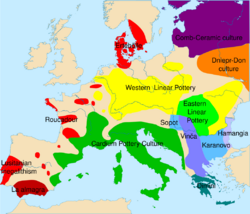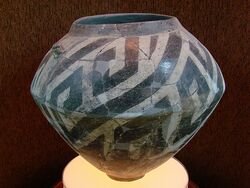History:Karanovo culture
 | |
| Horizon | Old Europe, First Temperate Neolithic |
|---|---|
| Period | Neolithic, Chalcolithic |
| Dates | circa 7th millennium BC — 4,000 BC |
| Type site | Karanovo |
| Preceded by | Mesolithic Europe |
| Followed by | Hamangia culture, Varna culture, Gumelnița culture, Cernavodă culture |
The Karanovo culture (Bulgarian: Карановска култура, romanized: Karanovska kultura) is a Neolithic culture (Karanovo I-III ca. 62nd to 55th centuries BC) named after the Bulgarian village of Karanovo, Sliven Province (bg) (Караново, Sliven Province [ ⚑ ] 42°30′41″N 25°54′54″E / 42.51139°N 25.915°E). The culture, which is part of the Danube civilization, is considered the largest and most important of the Azmak River Valley agrarian settlements.[1]
Discovery
Archaeologists discovered the Karanovo settlement in the 1930s when a tell - a settlement mound - was excavated at Karanovo.[1] The hilltop settlement is constituted of 18 buildings, which housed some 100 inhabitants. The site was inhabited more or less continuously from the early 7th to the early 2nd millennia BC. The Karanovo culture served as the foundation of the East Balkan cultural sequence.[2] The layers at Karanovo are employed as a chronological system for Balkans prehistory. This culture had seven major phases: Karanovo I and II, which existed parallel to Starčevo; Karanovo III (Veselinovo); Karanovo IV; Karanovo V (Marica); Karanovo VI (Gumelniţa); and, Karanovo VII, which emerged during the Early Bronze Age.[2] The Karanovo I is considered a continuation of Near Eastern settlement type.[3] Karanovo VI appeared to have collapsed around 4000 BC without any signs of conquest or resettlement.[4]
Characteristics
Some of the main characteristics of the Karanovo culture are the white-painted pottery and dark-painted vessels obtained from the tell.[5] These artifacts were particularly associated with the first and second phases.[6] There is also the case of The Gumelnita Lovers, a terracotta statuette crafted from 5000-4750 BCE.[7] This artifact, which was excavated at the Gumelnita Tell in southern Romania, is associated with the culture's notion of fertility.[7] There is also the Karanovo macroblade technology, which featured semi-steep and steep retouching as well as the use of yellow flint with white spots.[8] This particular technology, which is also known as "Karanovo blade",[9] emerged during the culture's early Neolithic phase.[8] Scholars note its interesting length and width: 100 mm long and between 15 mm and 23 mm wide.[8]
Karanovo II is distinguished from its predecessor due to its influence on the Thracian culture, or the assimilation of its elements into those inherited from Karanovo I.[10] The basic characteristics of this phase continued until Karanovo III and were particularly pronounced in its coarsely made ware, such as pitchers, shallow dishes, and cylindrical vases (e.g. Kügel).[10]
The burial practices of Karanovo I and II were similar to the practices of other eastern Balkan cultures, such as the Kremikovci, Dudesti, and Ovcarovo cultures.[11]
Gallery
Pottery, 6th millennium BC (Karanovo I).[12]
Ceramic vessel, 5th millennium BC (Karanovo VI).[15]
Anthropomorphic vessel, 6th-5h mill. BC (Karanovo III-IV).[19]
Inscribed object, with possible numerical meaning.[20]
Jade amulet, 6th millennium BC (Karanovo I).[21]
Necklace, 6th millennium BC (Karanovo I).[22]
Karanovo tell, Bulgaria, excavation stratigraphy.[23][24]
See also
- Old Europe
- Prehistoric Europe
- Gumelnița–Kodžadermen-Karanovo VI complex
- Durankulak
- Solnitsata
- Tell Yunatsite
- List of ancient cities in Thrace and Dacia
- Perperikon
- Seuthopolis
Literature
- Stefan Hiller, Vassil Nikolov (eds.), Karanovo III. Beiträge zum Neolithikum in Südosteuropa Österreichisch-Bulgarische Ausgrabungen und Forschungen in Karanovo, Band III, Vienna (2000), ISBN:3-901232-19-2.
References
- ↑ Jump up to: 1.0 1.1 Danver, Steven L. (2015). Native Peoples of the World: An Encyclopedia of Groups, Cultures and Contemporary Issues. Oxon: Routledge. pp. 271. ISBN 9780765682222.
- ↑ Jump up to: 2.0 2.1 Gimbutas, Marija; Alseikaitė (1974). The Gods and Goddesses of Old Europe: 7000 to 3500 BC Myths, Legends and Cult Images. Berkeley, CA: University of California Press. pp. 248. ISBN 0-520-01995-4.
- ↑ Whittle, Alasdair; Hofmann, Daniela; Bailey, Douglass W. (2008) (in en). Living Well Together? Settlement and Materiality in the Neolithic of South-East and Central Europe. Oxbow Books. ISBN 978-1-78297-481-9.
- ↑ Stornoway, Jack (2019) (in en). Broken Timelines - Book 3: The Indo-Europeans and Harappans. Digital Ink Productions. ISBN 978-1-989604-36-6.
- ↑ Colledge, Sue; Conolly, James (2007). The Origins and Spread of Domestic Plants in Southwest Asia and Europe. Oxon: Routledge. pp. 93. ISBN 9781598749885. https://archive.org/details/originsspreadofd0000unse/page/93.
- ↑ Colledge, Sue; Conolly, James (2007). The Origins and Spread of Domestic Plants in Southwest Asia and Europe. Walnut Creek, CA: Left Coast Press. pp. 93. ISBN 978-1-59874-988-5. https://archive.org/details/originsspreadofd0000unse/page/93.
- ↑ Jump up to: 7.0 7.1 Reichard, Joy (2011) (in en). Celebrate the Divine Feminine. San Francisco, CA: Bush Street Press. pp. 105. ISBN 978-1-937445-18-8.
- ↑ Jump up to: 8.0 8.1 8.2 Reingruber, Agathe; Tsirtsoni, Zoï; Nedelcheva, Petranka (2017). Going West?: The Dissemination of Neolithic Innovations Between the Bosporus and the Carpathians, Volume 3. Oxon: Routledge. pp. 57, 61. ISBN 9781138714830.
- ↑ Reingruber, Agathe; Tsirtsoni, Zoï; Nedelcheva, Petranka (2017). Going West?: The Dissemination of Neolithic Innovations between the Bosporus and the Carpathians. Oxon: Routledge. pp. 16. ISBN 978-1-138-71483-0.
- ↑ Jump up to: 10.0 10.1 Boardman, John; Edwards, I. E. S.; Hammond, N. G. L.; Sollberger, E. (2003). The Cambridge Ancient History. Cambridge, UK: Cambridge University Press. pp. 115. ISBN 0-521-22496-9.
- ↑ Fowler, Chris; Harding, Jan; Hofmann, Daniela (2015) (in en). The Oxford Handbook of Neolithic Europe. Oxford: Oxford University Press. pp. 930. ISBN 978-0-19-954584-1.
- ↑ "Ceramic vessel". http://bulgarianheritage.bulgariana.eu/jspui/handle/pub/451.
- ↑ "Karanovo culture, tulip-shaped vase". http://elizabethhawksley.com/wp-content/uploads/2017/04/Tulip-vase-6000-BC-2.jpg.
- ↑ "Tulip vessel". http://bulgarianheritage.bulgariana.eu/jspui/handle/pub/449.
- ↑ "Ceramic vessel". http://bulgarianheritage.bulgariana.eu/jspui/handle/pub/461.
- ↑ "Altar from a cult scene". http://bulgarianheritage.bulgariana.eu/jspui/handle/pub/216.
- ↑ "Priestess from a cult scene". http://bulgarianheritage.bulgariana.eu/jspui/handle/pub/217.
- ↑ "Cult scene". http://www.europeanvirtualmuseum.it/reperti/115.htm.
- ↑ "Anthropomorphic vessel". http://bulgarianheritage.bulgariana.eu/jspui/handle/pub/364.
- ↑ Haarmann, Harald (2020). The Mystery of the Danube Civilisation. Marix Verlag. ISBN 9783843806466. https://books.google.com/books?id=tiLoDwAAQBAJ.
- ↑ "Amulet". http://bulgarianheritage.bulgariana.eu/jspui/handle/pub/398.
- ↑ "Beads". http://bulgarianheritage.bulgariana.eu/jspui/handle/pub/435.
- ↑ "Photo of the excavated Karanovo Tell site". https://luwianstudies.org/app/uploads/2021/09/210912_News_SEAC.jpg.
- ↑ "Photo of the excavated Karanovo Tell site". https://vagabond.bg/sites/default/files/issues/199/bulgaria%20top%20archaeological%20sites/karanovo%20tel.jpg.
- ↑ "Early contact between late farming and pastoralist societies in southeastern Europe". 2023. https://www.nature.com/articles/s41586-023-06334-8. "Tell Yunatsite in Bulgaria, associated with the Karanovo culture"
- ↑ "Tell Yunatsite". https://balkanheritage.org/tell-yunatsite-southern-bulgaria-recent-excavations-and-new-insights-on-the-chalcolithic-in-thrace-2/.
- ↑ "Archaeological Park Topolnitsa". https://exarc.net/members/venues/chavdar-topolnitsa-bg.
- ↑ "The chronological framework in Greece and Bulgaria between the late 6th and the early 3rd millennium BC". 2016. https://books.openedition.org/momeditions/503?lang=en.
External links
 |


















